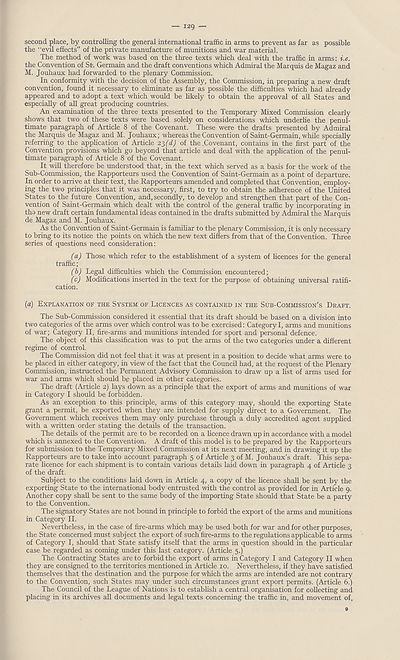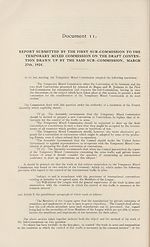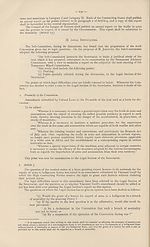Armament > Conference for the control of the international trade in arms, munitions and implements of war
(131)
Download files
Complete book:
Individual page:
Thumbnail gallery: Grid view | List view

— 129 —
second place, by controlling the general international traffic in arms to prevent as far as possible
the “evil effects” of the private manufacture of munitions and war material.
The method of work was based on the three texts which deal with the traffic in arms: i.e.
the Convention of St. Germain and the draft conventions which Admiral the Marquis de Magaz and
M. Jouhaux had forwarded to the plenary Commission.
In conformity with the decision of the Assembly, the Commission, in preparing a new draft
convention, found it necessary to eliminate as far as possible the difficulties which had already
appeared and to adopt a text which would be likely to obtain the approval of all States and
especially of all great producing countries.
An examination of the three texts presented to the Temporary Mixed Commission clearly
shows that two of these texts were based solely on considerations which underlie the penul¬
timate paragraph of Article 8 of the Covenant. These were the drafts presented by Admiral
the Marquis de Magaz and M. Jouhaux; whereas the Convention of Saint-Germain, while specially
referring to the application of Article 23(d) of the Covenant, contains in the first part of the
Convention provisions which go beyond that article and deal with the application of the penul¬
timate paragraph of Article 8 of the Covenant.
It will therefore be understood that, in the text which served as a basis for the work of the
Sub-Commission, the Rapporteurs used the Convention of Saint-Germain as a point of departure.
In order to arrive at their text, the Rapporteurs amended and completed that Convention, employ¬
ing the two principles that it was necessary, first, to try to obtain the adherence of the United
States to the future Convention, and, secondly, to develop and strengthen that part of the Con¬
vention of Saint-Germain which dealt with the control of the general traffic by incorporating in
tho new draft certain fundamental ideas contained in the drafts submitted by Admiral the Marquis
de Magaz and M. Jouhaux.
As the Convention of Saint-Germain is familiar to the plenary Commission, it is only necessary
to bring to its notice the points on which the new text differs from that of the Convention. Three
series of questions need consideration:
(a) Those which refer to the establishment of a system of licences for the general
traffic;
(b) Legal difficulties which the Commission encountered;
(c) Modifications inserted in the text for the purpose of obtaining universal ratifi¬
cation.
(a) Explanation of the System of Licences as contained in the Sub-Commission’s Draft.
The Sub-Commission considered it essential that its draft should be based on a division into
two categories of the arms over which control was to be exercised: Category I, arms and munitions
of war; Category II, fire-arms and munitions intended for sport and personal defence.
The object of this classification was to put the arms of the two categories under a different
regime of control.
The Commission did not feel that it was at present in a position to decide what arms were to
be placed in either category, in view of the fact that the Council had, at the request of the Plenary
Commission, instructed the Permanent Advisory Commission to draw up a list of arms used for
war and arms which should be placed in other categories.
The draft (Article 2) lays down as a principle that the export of arms and munitions of war
in Category I should be forbidden.
As an exception to this principle, arms of this category may, should the exporting State
grant a permit, be exported when they are intended for supply direct to a Government. The
Government which receives them may only purchase through a duly accredited agent supplied
with a written order stating the details of the transaction.
The details of the permit are to be recorded on a licence drawn up in accordance with a model
which is annexed to the Convention. A draft of this model is to be prepared by the Rapporteurs
for submission to the Temporary Mixed Commission at its next meeting, and in drawing it up the
Rapporteurs are to take into account paragraph 5 of Article 3 of M. Jouhaux’s draft. This sepa¬
rate licence for each shipment is to contain various details laid down in paragraph 4 of Article 3
of the draft.
Subject to the conditions laid down in Article 4, a copy of the licence shall be sent by the
exporting State to the international body entrusted with the control as provided for in Article 9.
Another copy shall be sent to the same body of the importing State should that State be a party
to the Convention.
The signatory States are not bound in principle to forbid the export of the arms and munitions
in Category II.
Nevertheless, in the case of fire-arms which may be used both for war and for other purposes,
the State concerned must subject the export of such fire-arms to the regulations applicable to arms
of Category I, should that State satisfy itself that the arms in question should in the particular
case be regarded as coming under this last category. (Article 5.)
The Contracting States are to forbid the export of arms in Category I and Category II when
they are consigned to the territories mentioned in Article 10. Nevertheless, if they have satisfied
themselves that the destination and the purpose for which the arms are intended are not contrary
to the Convention, such States may under such circumstances grant export permits. (Article 6.)
The Council of the League of Nations is to establish a central organisation for collecting and
placing in its archives all documents and legal texts concerning the traffic in, and movement of,
9
second place, by controlling the general international traffic in arms to prevent as far as possible
the “evil effects” of the private manufacture of munitions and war material.
The method of work was based on the three texts which deal with the traffic in arms: i.e.
the Convention of St. Germain and the draft conventions which Admiral the Marquis de Magaz and
M. Jouhaux had forwarded to the plenary Commission.
In conformity with the decision of the Assembly, the Commission, in preparing a new draft
convention, found it necessary to eliminate as far as possible the difficulties which had already
appeared and to adopt a text which would be likely to obtain the approval of all States and
especially of all great producing countries.
An examination of the three texts presented to the Temporary Mixed Commission clearly
shows that two of these texts were based solely on considerations which underlie the penul¬
timate paragraph of Article 8 of the Covenant. These were the drafts presented by Admiral
the Marquis de Magaz and M. Jouhaux; whereas the Convention of Saint-Germain, while specially
referring to the application of Article 23(d) of the Covenant, contains in the first part of the
Convention provisions which go beyond that article and deal with the application of the penul¬
timate paragraph of Article 8 of the Covenant.
It will therefore be understood that, in the text which served as a basis for the work of the
Sub-Commission, the Rapporteurs used the Convention of Saint-Germain as a point of departure.
In order to arrive at their text, the Rapporteurs amended and completed that Convention, employ¬
ing the two principles that it was necessary, first, to try to obtain the adherence of the United
States to the future Convention, and, secondly, to develop and strengthen that part of the Con¬
vention of Saint-Germain which dealt with the control of the general traffic by incorporating in
tho new draft certain fundamental ideas contained in the drafts submitted by Admiral the Marquis
de Magaz and M. Jouhaux.
As the Convention of Saint-Germain is familiar to the plenary Commission, it is only necessary
to bring to its notice the points on which the new text differs from that of the Convention. Three
series of questions need consideration:
(a) Those which refer to the establishment of a system of licences for the general
traffic;
(b) Legal difficulties which the Commission encountered;
(c) Modifications inserted in the text for the purpose of obtaining universal ratifi¬
cation.
(a) Explanation of the System of Licences as contained in the Sub-Commission’s Draft.
The Sub-Commission considered it essential that its draft should be based on a division into
two categories of the arms over which control was to be exercised: Category I, arms and munitions
of war; Category II, fire-arms and munitions intended for sport and personal defence.
The object of this classification was to put the arms of the two categories under a different
regime of control.
The Commission did not feel that it was at present in a position to decide what arms were to
be placed in either category, in view of the fact that the Council had, at the request of the Plenary
Commission, instructed the Permanent Advisory Commission to draw up a list of arms used for
war and arms which should be placed in other categories.
The draft (Article 2) lays down as a principle that the export of arms and munitions of war
in Category I should be forbidden.
As an exception to this principle, arms of this category may, should the exporting State
grant a permit, be exported when they are intended for supply direct to a Government. The
Government which receives them may only purchase through a duly accredited agent supplied
with a written order stating the details of the transaction.
The details of the permit are to be recorded on a licence drawn up in accordance with a model
which is annexed to the Convention. A draft of this model is to be prepared by the Rapporteurs
for submission to the Temporary Mixed Commission at its next meeting, and in drawing it up the
Rapporteurs are to take into account paragraph 5 of Article 3 of M. Jouhaux’s draft. This sepa¬
rate licence for each shipment is to contain various details laid down in paragraph 4 of Article 3
of the draft.
Subject to the conditions laid down in Article 4, a copy of the licence shall be sent by the
exporting State to the international body entrusted with the control as provided for in Article 9.
Another copy shall be sent to the same body of the importing State should that State be a party
to the Convention.
The signatory States are not bound in principle to forbid the export of the arms and munitions
in Category II.
Nevertheless, in the case of fire-arms which may be used both for war and for other purposes,
the State concerned must subject the export of such fire-arms to the regulations applicable to arms
of Category I, should that State satisfy itself that the arms in question should in the particular
case be regarded as coming under this last category. (Article 5.)
The Contracting States are to forbid the export of arms in Category I and Category II when
they are consigned to the territories mentioned in Article 10. Nevertheless, if they have satisfied
themselves that the destination and the purpose for which the arms are intended are not contrary
to the Convention, such States may under such circumstances grant export permits. (Article 6.)
The Council of the League of Nations is to establish a central organisation for collecting and
placing in its archives all documents and legal texts concerning the traffic in, and movement of,
9
Set display mode to:
![]() Universal Viewer |
Universal Viewer | ![]() Mirador |
Large image | Transcription
Mirador |
Large image | Transcription
Images and transcriptions on this page, including medium image downloads, may be used under the Creative Commons Attribution 4.0 International Licence unless otherwise stated. ![]()
| League of Nations > Armament > Conference for the control of the international trade in arms, munitions and implements of war > (131) |
|---|
| Permanent URL | https://digital.nls.uk/195383466 |
|---|
| Shelfmark | LN.IX |
|---|
| Description | Over 1,200 documents from the non-political organs of the League of Nations that dealt with health, disarmament, economic and financial matters for the duration of the League (1919-1945). Also online are statistical bulletins, essential facts, and an overview of the League by the first Secretary General, Sir Eric Drummond. These items are part of the Official Publications collection at the National Library of Scotland. |
|---|---|
| Additional NLS resources: |
|

